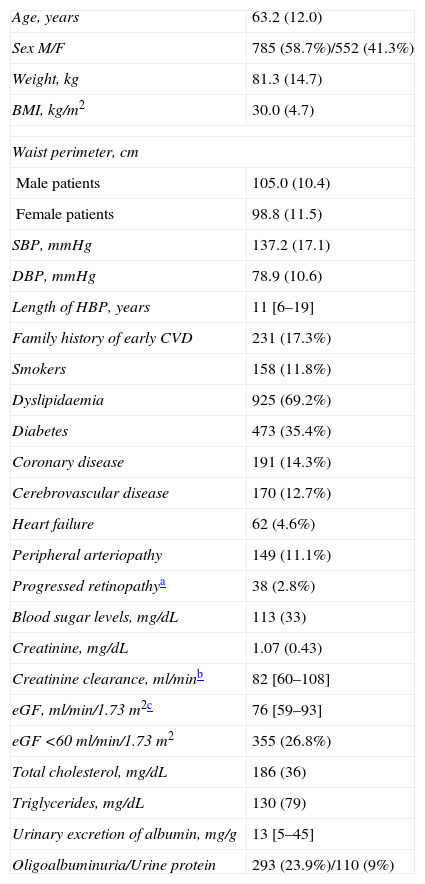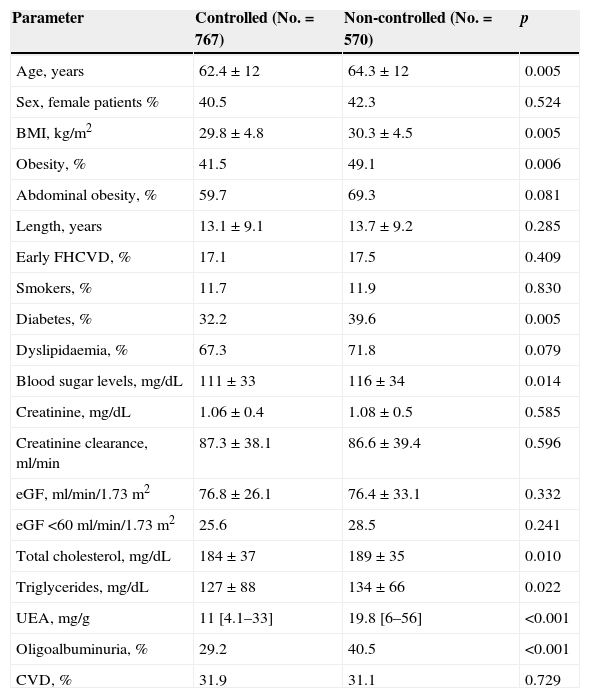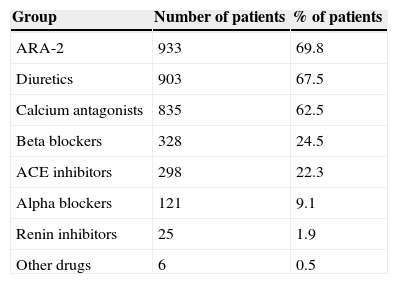The impact of antihypertensive treatment on blood pressure (BP) control is fairly unknown. The aim of the study was to evaluate the degree of BP control and its relationship with treatment-related factors in hypertensive patients treated with two or three agents and attended in referral units.
Patients and methodsWe studied 1337 hypertensive subjects (41% women) with a mean age (SD) of 63 (12) years, who were receiving two or three antihypertensive drugs. The degree of BP control was estimated in a single visit by the proportion of patients with BP below 140/90mmHg.
ResultsBP was controlled in 767 patients (57%). Lack of BP control was related to older age (12% risk for each 10-year increase) and the presence of microalbuminuria (64% risk increase). In those treated with two agents, BP control was 61%, without differences between those treated with fixed-drug or free combinations. BP control in those treated with three agents was 55%, higher in those receiving three agents in a fixed-drug combination (68%) compared with those on three agents administered separately (52%; p=0.025). Drug classes used in combinations did not influence the degree of BP control.
ConclusionsThe degree of BP control in patients treated with two or three agents is 57%. Microalbuminuria is related to a lack of BP control. In those receiving three agents, the use of fixed-drug combinations is associated with better BP control.
El impacto del tratamiento antihipertensivo sobre el control de la presión arterial (PA) es poco conocido. El objetivo del estudio ha sido examinar el grado de control de la PA y su relación con aspectos derivados del tratamiento en hipertensos tratados con 2 o 3 fármacos y atendidos en unidades hospitalarias.
Pacientes y métodoSe han estudiado 1.337 hipertensos (41% mujeres) con una edad media (DE) de 63 (12) años, en tratamiento con 2 o 3 fármacos antihipertensivos. El grado de control se ha estimado en una única visita, calculando la proporción de pacientes con cifras inferiores a 140/90mmHg.
ResultadosUn total de 767 pacientes (57%) tenían las cifras de PA controladas. El riesgo de mal control tensional se incrementaba con la edad (12% para cada 10 años) y con la presencia de oligoalbuminuria (64% de incremento). En los tratados con 2 fármacos, el grado de control fue del 61%, sin diferencias entre combinaciones fijas o libres. Los tratados con 3 fármacos presentaban tasas de control del 55%, mayores en los que recibían una asociación fija de los 3 antihipertensivos (68%) frente a los 3 fármacos por separado (52%; p=0,025). Los principios farmacológicos utilizados en las combinaciones no influyeron en el grado de control.
ConclusionesEl 57% de los pacientes en tratamiento con 2 o 3 antihipertensivos tiene sus cifras de presión controladas. La presencia de oligoalbuminuria se asocia al mal control. En los tratados con 3 fármacos, la utilización de asociaciones fijas se asocia con mayor control.
Artículo
Comprando el artículo el PDF del mismo podrá ser descargado
Precio 19,34 €
Comprar ahora










